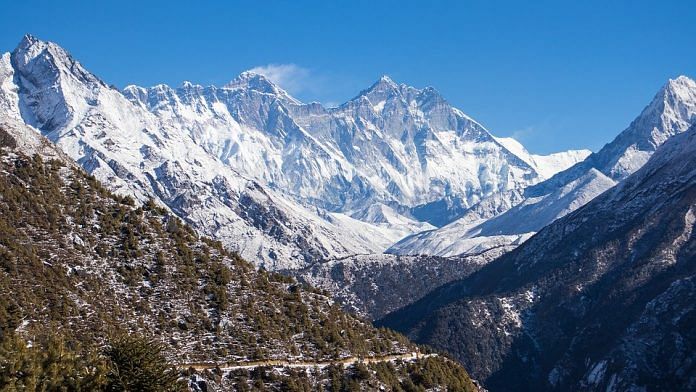Bengaluru: Discarded plastic oxygen cans, wrappers of chocolates and energy bars, disposable medical waste, empty food cans, alcohol bottles, aluminum ladders, and climbing equipment: These were some of the items Nepalese sherpas recovered as they completed a six-week clean-up drive on Mount Everest this week.
The team altogether found 11,000 kg of garbage left behind over several decades and four bodies that are yet to be identified.
The trash recovered from the world’s highest mountain is just another reminder of the growing number of people who attempt, and succeed, to summit the Everest, which stands over 8,800 metres above sea level.
Tourism at Mt Everest is one of Nepal’s highest revenue generators: Each permit to scale the peak costs $11,000 or nearly Rs 8 lakh. This year alone, Nepal has issued 381 permits, despite bad weather. Since each tourist is required to be accompanied by one sherpa, it can be safely assumed that over 760 people have attempted the steep, treacherous climb so far in 2019.
Scaling the summit
There are several camps on the way to the Everest summit. The famous Base Camp at 5,400m is one of the most popular mountaineering destinations in the world, and the temperature here swings from a June high of 17°C to a January low of -17°C. The Base Camp, by no means an easy hike, is open all year.
There are four camps between the heights of 6,000 and 8,000 metres along the southern approach, which begins near Kathmandu.
Located at 6,000 m, 6,500 m, 7,500 m, and 7,900 m, these camps mark places where climbers can halt on stable ground and rest for the nights. The conditions at each stop get progressively worse as the oxygen levels drop and the territory becomes more treacherous.
Another 900 m hike on exceedingly dangerous grounds takes the climbers to the summit of Mt Everest.
The area from Camp 4 onwards is called ‘death zone’, where conditions are too harsh to support human life: Most of the over 300 people who have died during the climb over the years lost their lives here.
The low temperatures and low oxygen availability can cause organ failure or loss of limbs through frostbite. The conditions also affect the brain, and stressful situations can often lead to unwise and unsafe decisions. They can also spur dizziness, delusions, hallucinations, loss of consciousness, and even death due to hypoxia (oxygen deprivation). Often, the extreme cold simply numbs the senses, especially touch, and causes trivial accidents that can snowball into catastrophes.
The struggles, however, don’t end at the summit: Climbing down is no easier.
Even climbers who have previously summitted Everest have died on subsequent attempts. Babu Chiri Sherpa of Nepal had reached the summit 10 times, with at least two world records to his name, but died in April 2001 when he fell into a crevasse near Camp 2. He was 35.
New Zealander Rob Hall, also 35, was the first non-sherpa to have climbed the summit five times, but died during a climb in May 1996. One of the deadliest years for Everest was 1996, when 15 people died, eight of them on the same day.
Experienced Apollo astronaut Karl Gordon Henize, 66, died at the base camp in October 1993.
Despite better gear and awareness, the deaths have continued. This year, at least 11 people died last month, just as a photo showing a large queue to the summit went viral.

Plastic pollution
As more and more people reach the summit every year — a record 807 did in 2018 — there’s a whole lot of supplies that are taken up.
One of the most common equipment is supplemental oxygen, which comes in a tank that resembles a large water bottle in shape and size.
When Edmund Hillary and Tenzing Norgay became the first people to reach the summit in May 1953, they did so with bottled oxygen. Nearly everyone followed suit, although several people have successfully accomplished the feat without it. When used up, these bottles are discarded to reduce weight during the descent.
The 14-member sherpa team that undertook the cleaning mission this April-May collected nearly 6,000 kg of trash on the way to the base camp and over 5,000 kg between the Base Camp and Camp 4.
The bags of trash were then flown by military helicopters to the Nepalese capital of Kathmandu as well as carried away by trucks through winding mountainous roads. They were then sent to a local recycling company on World Environment Day, Wednesday.
The climate effect
A sizeable chunk of this trash could only be collected because the ongoing climate emergency has caused temperatures to rise, thawing ice and exposing plastic buried underneath the top layers of snow.
Deaths and dangers on the mountain are only expected to go up as global heating melts the snow and causes slippery conditions.
Another threat lies in the air pollutants that are being trapped by snow during the winters, which is causing changes in the structure of ice and snow, further endangering climbers attempting to make their presence felt in the history books.
Also read: Relax against corruption says R Jagannathan, Stephen Alter on death in the Himalayas







$ 11,000 per climbing permit – plus some income generated for Sherpas and others who assist – is not a substantial sum. There has been a large loss of life this season. The pristine environment of Everest and the route leading up to it is being overwhelmed by the human presence and its functional requirements. While it remains the ultimate dream for each mountaineer to reach its summit, 4,000 people have made it so far. 200 have perished in the effort. So it is time to acknowledge that an era of adventure and excitement has passed. It would be for the government of Nepal to restore some of the mystique and aura of Sagarmatha.